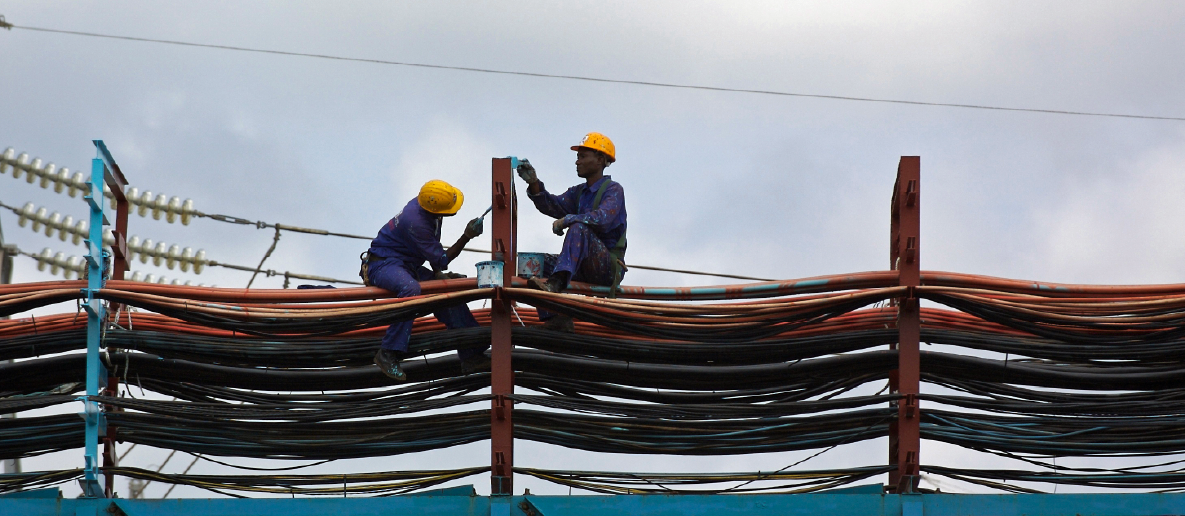 The blog argues that argues that transmission infrastructure is a stable operating asset with adequate technologies. In the picture, workers maintain the thermal power station at Takoradi, Ghana. Photo: Jonathan Ernst/World Bank
The blog argues that argues that transmission infrastructure is a stable operating asset with adequate technologies. In the picture, workers maintain the thermal power station at Takoradi, Ghana. Photo: Jonathan Ernst/World Bank
Electricity transmission is a complex industry with fixed costs and uncertainties surrounding right-of-way and regulatory approvals which can cause significant delays, sometimes lasting years, or even permanently halt projects. In the United States, according to a recent article by the Department of Energy, "Queued Up…But in Need of Transmission", over 930 gigawatts (GW) of solar, wind, hydropower, geothermal, and nuclear capacity are currently waiting in interconnection queues for transmission access, along with over 420 GW of energy storage. In addition, financing transmission assets can be challenging, particularly in emerging markets and developing economies (EMDEs), where state-owned monopolies often own most of the transmission infrastructure and may be in financial distress. This can limit the scope and scale of optimal network expansion when financed on their own balance sheet.
A new World Bank Policy Research Working Paper, argues that transmission infrastructure is a stable operating asset with proven technologies that have remained largely unchanged for over a century. Furthermore, transmission costs typically account for only around 10 percent of the delivered cost of electricity.
Efficient, safe, and reliable delivery of power
Most countries are transitioning to cleaner forms of power generation, which often involves building large-scale solar or wind facilities in remote areas away from the main grid. However, connecting these facilities to the grid requires upgrading and modernizing the entire network to ensure efficient, safe, and reliable delivery of power. Despite its importance, transmission planning has often been neglected in favor of renewable generation, storage, and hydrogen. This has delayed the adoption of renewables, particularly in the USA, and has hindered decarbonization efforts. It is crucial to prioritize transmission planning to facilitate the entry of renewables at scale and achieve decarbonization goals. As RMI aptly puts it: “The best time to plan transmission was 15 years ago. The second-best time is now”.
Simply running planning models or fast-tracking the regulatory approvals is not enough to address the fundamental issue of how transmission is viewed and labeled as "green." The current taxonomy, such as that put in place by the EU, only considers transmission and network to be green if stringent criteria are met, such as having CO2 emissions intensity below a certain level. It leaves out essential upgrades to the existing network, expansions to create parallel paths that ensure reliability, and smart grids that ensure security of the grid. Additionally, the timeframe allowed for planning is too short to see the long-term benefits of transmission lines, which have a lifespan of at least twice as long. Therefore, it is necessary to address these flaws in the methodology to prioritize transmission planning and achieve decarbonization goals.
Green transmission: A strong case for a broader definition
To fully achieve decarbonization goals, the planning methodology must be extended to the long-term and co-optimized with a green generation plan. This means that upgrades, expansions, and modernization projects should be considered green as they are essential components of the decarbonization plan. A broader definition of green transmission is necessary to appreciate the holistic and systemwide view of transmission planning.
In our paper, we have articulated a methodology that combines elements of generation and transmission planning and provided motivating illustrative examples that may help to appreciate a broader definition of green transmission. If that sounds like “greenwashing” think again because a constant opposition to transmission projects including the latest myopic definition of green transmission has already caused enough damage to the very goal of greening power system including diverting finance away from critical transmission infrastructure. There is a particularly strong case for a broader definition of green transmission and better planning in the developing world because the transmission networks in these countries owned by financially weak state-owned transmission entities desperately need investments. They need investments to move to the next higher voltage level, rendering the grid reliable and smart so that the grid can accommodate substantial amount of solar and wind, regardless of where these resources are developed including in a neighboring country. And with the rightful acknowledgment of transmission finance as "green investments", mobilization of private capital from institutional or impact investors through use of growing instruments such as Infrastructure Investment Trusts (InvIT) or Sustainable Bonds can further address the capital needs. It can also help transmission projects access concessional climate finance where appropriate.
Transmission infrastructure is a cost-effective way to facilitate private investment in cleaner generation, as creating a MW of transmission capacity costs less than its generation counterpart. Implementing a broader definition of green transmission may face challenges, such as data and computational issues, but the mental shift to view transmission positively is crucial. This shift is especially important for coal-heavy countries like India, Indonesia, Kazakhstan, and South Africa, where implementing transmission infrastructure can accelerate the transition to cleaner forms of power generation.



Join the Conversation